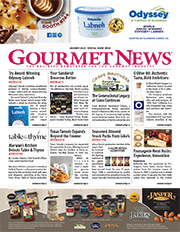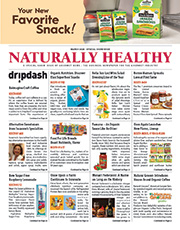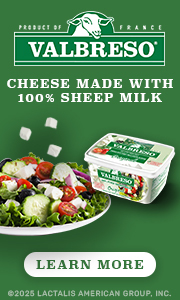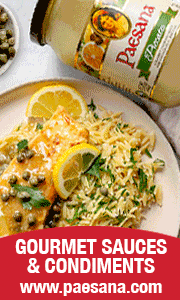Taco Bell at Home Introduces Crunchwrap, Quesadilla ‘Craving Kits’
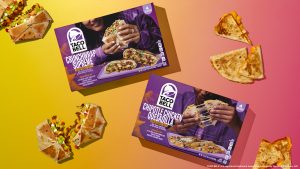 Taco Bell fans have long taken to social media to recreate their favorite menu items at home, but their creations never taste quite the same without the brand’s ingredients. Taco Bell at Home has introduced the first Crunchwrap Supreme and Chipotle Chicken Quesadilla “Cravings Kits,” featuring proprietary Taco Bell restaurant ingredients, seasonings and sauces essential to making these fan-favorites at home. The Craving Kits are the latest offerings from Kraft Heinz’s Taco Bell at Home line designed to make it easier than ever for fans to recreate and personalize their takes on beloved menu items.
Taco Bell fans have long taken to social media to recreate their favorite menu items at home, but their creations never taste quite the same without the brand’s ingredients. Taco Bell at Home has introduced the first Crunchwrap Supreme and Chipotle Chicken Quesadilla “Cravings Kits,” featuring proprietary Taco Bell restaurant ingredients, seasonings and sauces essential to making these fan-favorites at home. The Craving Kits are the latest offerings from Kraft Heinz’s Taco Bell at Home line designed to make it easier than ever for fans to recreate and personalize their takes on beloved menu items.
“A partnership founded on a mutual obsession with their consumers, Kraft Heinz and Taco Bell created the Taco Bell at Home line to bring signature and crave worthy Taco Bell offerings and flavors straight to the grocery aisle and allow fans to make Taco Bell their way,” said Danielle Coopersmith, associate director of marketing for Taco Bell at Home. “Grounded in this core mission, our innovation strategy focuses on creating new products inspired by beloved Taco Bell classics that encourage fans to customize their at-home creations and take them to new heights.”
Perhaps the most iconic menu item in Taco Bell’s history, the Crunchwrap Supreme has taken the internet by storm with product videos – especially fans creating their own versions – garnering more than 50 million views on TikTok as of December. The quesadilla was one of Taco Bell’s best-selling menu items in 2023, and the chipotle sauce adds a kick to the comforting and consistent classic. Now, whether cooking solo for the first time, entertaining a crowd, or just in need of crunchy, cheesy goodness after a long day, fans can treat themselves to Taco Bell-approved versions of both.
“Our release of the Cravings Kits – the first of several Taco Bell at Home innovations planned for this year – is a great example of how Kraft Heinz is delivering against its goal to lead the future of food,” said Alan Kleinerman, vice president of disruptive innovation at The Kraft Heinz Company. “As we kick off 2024, we’re focused on finding the white spaces at retail where we can make an impact for fans and develop products we know they will be excited to try. Our partnership with Taco Bell is a great example of this.”
Now rolling out exclusively in Walmart stores and online nationwide, each Cravings Kit includes four servings of essential ingredients – just add a protein, any personalized additions to customize the creation, and enjoy from the comfort of your home. The Cravings Kits join a growing portfolio of products that make it possible to experience Taco Bell anywhere, anytime.
Taco Bell is a registered trademark owned and licensed by Taco Bell IP Holder, LLC.
For more news of interest to the foodservice industry, subscribe to Gourmet News.
NGA Announces Senior Staff Executive Promotions
 The National Grocers Association announced promotions for three key senior staff executives, all NGA veterans.
The National Grocers Association announced promotions for three key senior staff executives, all NGA veterans.
In announcing these promotions, NGA President and CEO Greg Ferrara said, “NGA is fortunate to have a strong and committed group of senior leaders who bring their experiences and expertise to bear every day for the benefit of our membership. Their unwavering commitment, exceptional leadership and invaluable contributions have been instrumental in NGA’s success, and I am confident their continued leadership will help drive this organization to new heights.”
Jonathan Downey is now chief operating officer and senior vice president. Downey is a nearly four-year veteran of NGA, having joined the organization in early 2020 to lead industry relations and business development. Today he is responsible for membership growth, events, administration, and business development, including helping associate member companies achieve their business growth goals by engaging with NGA’s members. Downey is a long-time trade association executive, having previously worked for the Consumer Brands Association, a leading trade association representing consumer package goods companies. Additionally, Downey is a Certified Association Executive through ASAE.
Christopher Jones is now chief government relations officer & counsel and senior vice president. Jones is a six-year veteran of NGA, having joined in 2017 from the U.S. House of Representatives, where he served as legislative director for a senior member of congress on the Agriculture Committee. Jones leads NGA’s government relations, legal, and political operations, ensuring NGA’s member companies have a strong and influential voice in before Congress and federal agencies. He also leads the organization’s historic efforts to revive and enforce the Robinson-Patman Act and other important antitrust laws, key to ensuring Main Street and regional grocers can compete on a level playing field for the benefit of consumers.
Laura Strange is now chief communications and engagement officer and senior vice president. Strange is a 10-year veteran of NGA, having joined NGA in 2013 from the U.S. House of Representatives, where she served as the communications director for a senior member of congress on the Energy and Commerce Committee. Within NGA, Strange leads internal departments responsible for all press and public affairs engagement, member communications, marketing, as well as member engagement and retention. Strange also leads important member programs such as NGA’s share groups, the NGA Creative Choice Awards program sponsored by Kellanova and Unilever and the NGA Best Bagger competition, sponsored by PepsiCo.
For more news of interest to the grocery industry, subscribe to Gourmet News.
Steeped Offers Alternative as Compostable Gourmet Coffee Bags
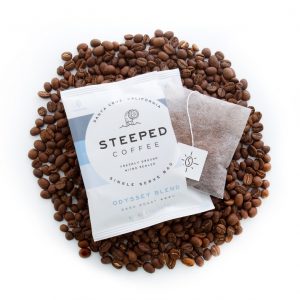 Steeped Coffee, a Certified B Corp, is celebrating National Gourmet Coffee Day this Jan. 18 with a non-traditional ask for gourmet coffee lovers: reduce your coffee waste. Steeped is leading a movement to reduce the world’s dependence on non-recyclable, single-serve coffee pods, and has pioneered a revolutionary single-serve brewing method that preserves the full flavor of gourmet coffee while being fully compostable and requiring no brewing machinery.
Steeped Coffee, a Certified B Corp, is celebrating National Gourmet Coffee Day this Jan. 18 with a non-traditional ask for gourmet coffee lovers: reduce your coffee waste. Steeped is leading a movement to reduce the world’s dependence on non-recyclable, single-serve coffee pods, and has pioneered a revolutionary single-serve brewing method that preserves the full flavor of gourmet coffee while being fully compostable and requiring no brewing machinery.
More than 10 billion single-serve coffee pods end up in landfills each year. The number of pods consumed since 2009 could wrap around the planet more than 500 times. With a process brewed similar to tea, Steeped is helping to make quality coffee from hundreds of top brands accessible and sustainable. Steeped Packs contain craft-roasted, freshly ground pre-portioned coffee that is triple nitro-sealed to guarantee each perfect, “barista-approved” cup. The company’s Guilt-Free Packing is commercially compostable, from the outer packaging to the inner Steeped Brew Bags.
“At Steeped, we are changing the way people view single-serve coffee, delivering all of the benefits with none of the barriers,” said Josh Wilbur, founder and CEO. “We are proud to help drive a global movement to reduce our impact on the planet.”
Steeped was honored in 2023, making the 2023 Inc. Magazine’s Best in Business list, USA Today’s 10Best List and Good Housekeeping’s list of top coffee makers. More than 500 top roasters across the country now use the company’s revolutionary Steeped Brewing Method. Steeped Packs are available for purchase online, at grocery stores or through hospitality, office and other wholesale providers.
“Steeped doesn’t take its barista-approved standards lightly and we’ve worked closely with industry leading experts to validate every aspect of the Steeped Method from freshness, quality, extraction, shelf life, and most importantly, consistent taste to bring the most authentic specialty experience directly to single-serve coffee lovers,” Wilbur said. “We are proud of the incredible partnerships we’ve forged with the industry’s top specialty coffee roasters, including names like Counter Culture, Addictive and Cat and Cloud.”
Steeped Coffee features include:
● 100 percent specialty coffee: quality coffee ethically sourced directly from farmers
● Steeped Brew Bag: non-GMO filters that regulate ideal water-in and maximum flavor-out
● Guilt-free packaging: made using plant-based renewable and compostable materials
● Nitro sealed: removes oxygen, stopping the clock on freshly ground beans
● Pre-portioned single-serve: only brew what you use, reducing wasteful consumption
● Precision ground: consistent water-cooled grinding to the micron
● Just add water: single-serve convenience with no machines required
● Barista approved: tested by multiple independent specialty coffee Q-graders for freshness, quality, and taste
Steeped, Inc. based in San Francisco, is a Certified B Corp and Benefit Corporation focused on every detail from farm-to-cup and beyond, to bring people the most convenient, quality, ethically sourced, and sustainably packaged products available. Steeped is the new standard in coffee helping to make quality coffee more accessible through its proprietary technology and Steeped Brewing Method that is licensed to over 500 of the top specialty roasters around the globe. Steeped delivers 100 percent freshly roasted, precision ground, and nitro-sealed specialty coffee pre-portioned within Steeped Brew Bags. Steeped Coffee is the simplest way to make a perfect cup of coffee by just adding water, with no machine needed. Welcome to Coffee Simplified.
For more news of interest to the specialty beverage industry, subscribe to Gourmet News.

